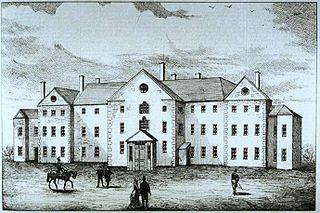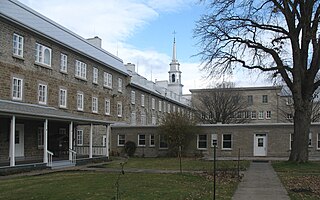 W
WThe Château Ramezay is a museum and historic building on Notre-Dame Street in Old Montreal, opposite Montreal City Hall in Montreal, Quebec, Canada.
 W
WThe Chateau St. Louis in Quebec City was the official residence of the French Governor of New France and later the British Governor of Quebec, the Governor-General of British North America, and the Lieutenant-Governor of Lower Canada.
 W
WL'Église de la Visitation de la Bienheureuse-Vierge-Marie is a church in the neighbourhood of Recollet Falls in Montreal. The oldest church on the island of Montreal, it was built between 1749 and 1752.
 W
WThe Citadelle of Quebec, also known as La Citadelle, is an active military installation and the secondary official residence of both the Canadian monarch and the Governor General of Canada. It is located atop Cap Diamant, adjoining the Plains of Abraham in Quebec City, Quebec. The citadel contains the oldest military building in Canada, and forms part of the fortifications of Quebec City, which is one of only two cities in North America still surrounded by fortifications, the other being Campeche, Mexico.
 W
WThe Ecole des Ursulines, known in English as the School of the Ursulines, is among North America's oldest schools. Still operating as a private school for both girls and boys, it was founded in 1639 by French nun Marie of the Incarnation and laywoman Marie-Madeline de Chauvigny de la Peltrie. This was also the beginning of the Ursuline order in New France.
 W
WThe Fort de la Montagne was an old fortification, the remaining structures of which are located on Sherbrooke Street in Montreal, Quebec, Canada. The fort was constructed in 1685 and parts of it were demolished in the mid 19th century. Two 13-metre (43 ft) high stone towers, built in 1694 as bastions of the fort, still remain and are among the oldest structures on the Island of Montreal.
 W
WFort Longueuil was a stone fort that stood in Longueuil, Canada from 1690 to 1810.
 W
WThe Grey Nuns' Hospital was a hospital in Montreal, Quebec, Canada that operated from 1695 to 1880. It is located south of Place d'Youville and west of Rue Saint-Pierre.
 W
WThe Hôpital-Général de Québec is a Canadian medical facility located in the tiny municipality of Notre-Dame-des-Anges, Quebec, surrounded by the La Cité-Limoilou borough of Quebec City. It was classified as an historic site in 1977 by the Quebec government. Additionally, an archeological site listed on the Inventaire des sites archéologiques du Québec is located there.
 W
WLe Ber-Le Moyne House is the oldest complete building in Montreal, Quebec, Canada. It is located in the borough of Lachine, bordering the Saint Lawrence River, between the Lachine Rapids and Lake Saint-Louis. It is a recognized National Historic Site of Canada since June 19, 2002. The Le Ber-Le Moyne site and its archaeological collection have also been classified as heritage assets by the ministère de la Culture et des communications du Québec since 2001.
 W
WThe Maison Saint-Gabriel Museum is located in Montreal, Quebec and is dedicated to preserving the history, heritage and artifacts of the settlers of New France in the mid 17th century. The museum consists of a small farm, which has been administered for more than 300 years by the Sisters of the Congregation of Notre Dame of Montreal, founded by Marguerite Bourgeoys in Montreal in 1658.
 W
WThe Notre-Dame Church was a church in Old Montreal that stood from 1682 until 1830. From 1821 to 1822, it served as the first cathedral of the Diocese of Montreal.
 W
WNotre-Dame-des-Anges is a parish municipality in Quebec, Canada, home of the General Hospital of Quebec.
 W
WThe Saint-Sulpice Seminary is a building in Montreal, Quebec, Canada. It is the second oldest structure in Montreal and was declared a National Historic Site of Canada in 1980. It is located in the Ville-Marie Borough in the Old Montreal district, next to Notre-Dame Basilica on Notre-Dame Street, facing Place d'Armes. The seminary is a classic U-shaped building featuring a palatial style and includes an annex.
 W
WThe Seminary of Quebec is a Roman Catholic community of priests in Quebec City founded by Bishop François de Laval, the first bishop of New France in 1663.
 W
WThe Sillery Heritage Site, formerly known as the Sillery Historic District, is a territory containing historic residential and institutional properties, as well as woodlands, located in the Sainte-Foy–Sillery–Cap-Rouge borough of Quebec City, Canada. It is one of four heritage sites which are located in the City of Quebec. Having been called the "cradle of the Quebec nation," it includes approximately 350 buildings situated on a linear 3.5 kilometres wide landscape, which is alongside, as well as an integral part of the coast of the Saint Lawrence River. The built environment was constructed in all of the time periods, including and following the foundation of New France.